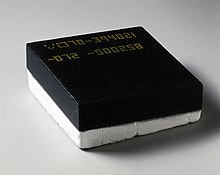Heat protection tile



Heat protection tiles are cladding elements that have a heat insulating function. They are mainly used in furnace construction for safety and energy saving purposes - but their best-known use is found on the space shuttle and other spacecraft that are built to allow an atmosphere to enter. The following article only deals with the second use.
The tiles form the largest part of the heat shield , which is intended to prevent the spaceship from burning up due to the enormous heat of compression when it enters the planet's atmosphere . Tile cladding is mainly used in spacecraft that can be reused several times; a space shuttle tile can survive up to around 100 re-entries without being destroyed by ablation . Heat protection shields for single use are rarely implemented in the form of tile cladding.
The heat is created by the forced convection of the atmospheric gas, caused by the very high speed. A space shuttle initially has about 27 times the speed of sound , i.e. about 33,300 km / h. The gas, which is heated up to the point of plasma, gives off (after heating) part of the heat through direct contact and radiation to the heat protection system of the spaceship.
Requirements and structure
Heat protection tiles for space travel must meet many requirements, in particular withstand extreme temperatures and at the same time have good thermal insulation; furthermore, they should be light. They are made from very low density ceramic composites . The material has to withstand both the conditions in space (depending on solar radiation, a few Kelvin above absolute zero to over 150 ° C) as well as the thousands of degrees Celsius hot plasma when entering the atmosphere. The tiles insulate the spaceship against the heat for a long enough time, both in space and when entering.
The tile-like covering of the spaceship structure is necessary to compensate for the thermal expansion and mechanical deformations without destroying the mechanically sensitive tiles. For this reason, the tiles, interrupted by expansion joints, are glued separately to the fuselage. Furthermore, small tiles lead to much less scrap during production: If the heat shield (of a space shuttle) were a single large component, a single production error would make the entire shield scrap; If the tile is defective, it only needs to be replaced, all others do not have to be produced again. Other reasons for tiles can be in production - for example, only small machines are required.
A typical (space shuttle) tile consists of a thin brittle layer of borosilicate , followed by by sintering the solidified silica fiber layer (thickness 2.5 to 12.5 cm), having a porosity of 90%, to about the necessary degree of heat insulation deliver. The tiles are therefore extremely light and delicate - they can be destroyed with the bare hand.
While the tiles glow brightly when they enter the atmosphere, you can touch them a short time later without danger. Due to the extremely low thermal conductivity, the greatest heat only occurs minutes after landing in the shuttle.
A total of around 30,000 tiles and various types of tiles were used on the space shuttle, depending on the thermal and mechanical load. Carbon fiber materials were used at critical points (e.g. wing edges) .
Limits of heat protection
If the heat shield is damaged during take-off or in space before the critical re-entry, this can have catastrophic consequences - as happened when the space shuttle Columbia was lost on flight STS-107 , which caused major damage to the space during take-off due to a piece of insulating foam that was broken off from the main tank The heat shield. The damage was on a wing edge that was protected with ceramic carbon fiber composites . Because of the critical position of the damage, the shield was unable to adequately protect the ferry when it re-entered, which ultimately led to the failure of the ship's structure and thus to the breakage and subsequent burn-up in the atmosphere.
On the other hand, damage to the tile covering after the critical phase of entry (the moment of the highest temperature and the interruption of radio contact) is relatively uncritical. Damage, such as loosened or loosened heat protection tiles, has already been identified several times, but this did not lead to a catastrophe. The ferries were inspected after landing, defective or missing tiles were made and replaced. For this purpose, each tile has an identifier which can be used to determine its position, thickness, shape and structure. An in-orbit repair procedure has also been developed.
See also
- Heat protection shield (comparison and examples of reusable and non-reusable heat protection systems)
Web links
- Heat protection of the space shuttle Buran (engl.) , U. a. with information on the material density and structure of the sintered quartz glass fiber layer as well as the need for expansion joints between the tiles and their influence on the insulating properties

